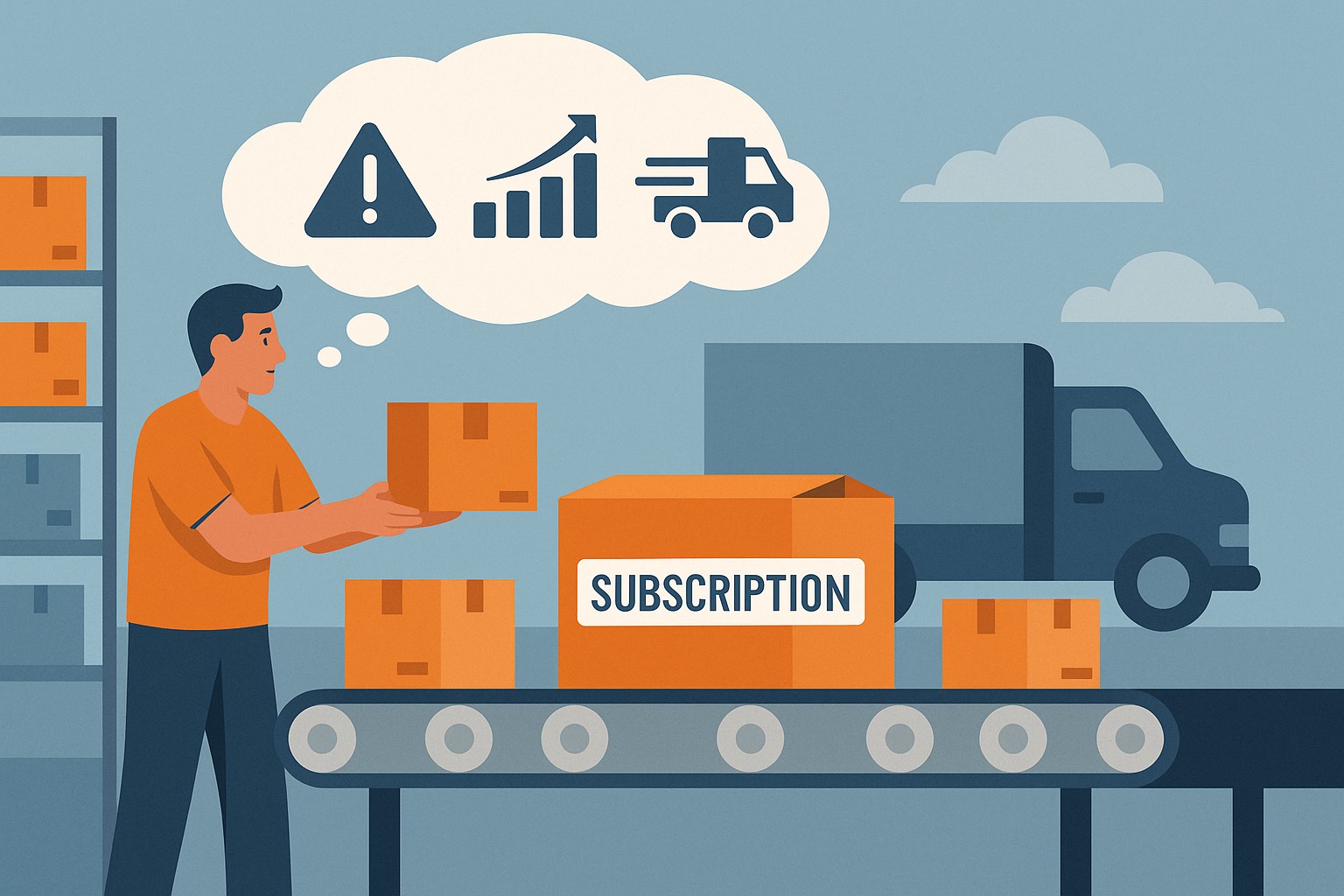Fulfillment challenges for subscription-based business mode

Last week, we talked about how predictive analytics is transforming warehouse management. Nowadays, technology is the pillar to improve and exceed your customers’ expectations.
And regarding your clients, the subscription-based business model has transformed the way companies build customer relationships, shifting the focus from one-time transactions to long-term engagement.
However, behind every seamless monthly delivery or automated renewal lies a complex fulfillment process that can make or break customer satisfaction. From inventory management and shipping logistics to demand forecasting and retention strategies, subscription businesses face unique operational hurdles that traditional retailers rarely encounter.
In this article, as a fulfillment center, we’ll explore the key fulfillment challenges for subscription-based business models, why they matter for scalability and customer loyalty, and what strategies can help brands streamline operations without compromising on the personalized experience subscribers expect.
Understanding the subscription-based business model
The subscription-based business model revolves around the idea of offering continuous access to a product or service in exchange for recurring payments. Instead of focusing on one-time purchases, this approach emphasizes long-term relationships, customer retention, and predictable revenue streams.
Popular examples include streaming services, subscription boxes, software-as-a-service (SaaS) platforms, and even curated eCommerce models that deliver personalized experiences.
Unlike traditional retail models, where customer engagement often ends after a single transaction, subscription businesses rely on ongoing value delivery. Every renewal cycle becomes an opportunity to reinforce brand trust and satisfaction.
This means that the customer journey doesn’t stop at checkout; it continues with every delivery, update, and interaction. As a result, maintaining consistent fulfillment quality is essential not only to meet customer expectations but also to reduce churn and build loyalty over time.
Fulfillment centers play a central role in this ecosystem. They are the bridge between customer promise and brand performance. Efficient order processing, inventory management, and delivery operations ensure that products arrive on time and in optimal condition.

Common fulfillment challenges in the subscription model
While the subscription model offers predictable revenue and strong customer relationships, it also introduces a unique set of operational hurdles. Below are some of the most common challenges that can affect efficiency, scalability, and customer satisfaction.
1.- Inventory and demand forecasting issues
One of the most pressing challenges is predicting demand accurately. Subscription businesses often deal with fluctuating order volumes, seasonal demand spikes, and customer churn, all of which make inventory management complex.
Overestimating demand can lead to overstocking and higher storage costs, while underestimating it can result in stockouts, delayed deliveries, and disappointed customers.
To overcome this, companies need data-driven forecasting systems that analyze purchase history, customer behavior, and renewal patterns. These tools can help identify trends and predict order volumes with greater precision, minimizing waste and optimizing warehouse operations.
2.- Managing product variability and personalization
Today’s subscribers expect personalized experiences. However, customizing each box or order introduces additional fulfillment complexity. Managing product variations, individual preferences, and customization options requires meticulous coordination between product selection, packing, and shipping teams.
A scalable solution involves leveraging automation and dynamic inventory systems that can match customer profiles with available stock in real time. Clear communication with suppliers and an integrated order management system can further ensure that every subscriber receives the right product mix, on time and as expected.
3.- Logistics and shipping complexities
Efficient logistics are at the core of subscription success. Businesses must handle high volumes of recurring deliveries with precision, often on tight schedules. As subscriber bases grow across multiple regions or countries, shipping costs, customs processes, and delivery delays can escalate quickly.
Partnering with reliable carriers and third-party logistics (3PL) providers can help mitigate these challenges. Many subscription companies also use technology to track shipments, optimize delivery routes, and offer customers real-time updates.
Strategies to overcome fulfillment challenges
Addressing fulfillment challenges in subscription-based businesses requires a combination of technological innovation, strategic partnerships, and customer-centric planning. Hereunder are key approaches that can help subscription businesses streamline their fulfillment processes and scale sustainably.

1.- Leveraging automation and smart inventory systems
Automation is one of the most powerful tools for improving fulfillment performance. Manual inventory management and order processing are prone to human error and inefficiency. Implementing automated inventory systems allows businesses to track stock levels in real time, prevent stockouts, and manage reordering more effectively.
Smart systems can also integrate directly with eCommerce platforms, customer databases, and warehouse operations. For example, automation can trigger purchase orders when inventory dips below a set threshold or adjust replenishment cycles based on predicted demand. This not only reduces administrative workload but also ensures consistent product availability.
2.- Partnering with 3PL providers
Many growing subscription-based companies reach a point where handling fulfillment internally becomes too costly or complex. Partnering with third-party logistics providers offers a practical solution.
These companies specialize in warehousing, packaging, and shipping operations, allowing subscription businesses to focus on product development, marketing, and customer experience. A strategic 3PL partnership can also provide access to regional distribution centers, faster delivery times, and negotiated carrier rates that reduce shipping costs.
3.- Using data analytics
We talked about this before; data-driven decision-making is essential for overcoming the unpredictability of subscription demand. By leveraging advanced analytics and predictive modeling, businesses can forecast order volumes, identify customer behavior patterns, and optimize procurement cycles.
Predictive analytics can also improve marketing and retention by identifying which customers are most likely to cancel and allowing companies to proactively engage them with personalized offers.
4.- Building a flexible supply chain
A rigid supply chain can quickly become a bottleneck for subscription businesses, especially during sudden demand spikes or global disruptions. To maintain resilience, companies need to design flexible supply chains that can adapt to shifting market conditions and customer needs.
This may involve diversifying suppliers, maintaining safety stock for high-demand products, or integrating real-time monitoring systems that detect potential disruptions early.
Flexibility also extends to packaging and shipping; offering multiple delivery options or dynamic packaging solutions based on order volume can enhance both efficiency and customer satisfaction.
Moreover, collaboration and transparency across the supply chain are key. Businesses that maintain close communication with suppliers and logistics partners can respond more quickly to changes, ensuring consistent fulfillment even in uncertain conditions.
In short, a subscription model for businesses is a key to success, but for it to work, it must be allied with a fulfillment center. If you have any questions or need assistance, don’t hesitate to contact us; one of our experts will be happy to help you. Share this article on social media and stay tuned to our blog for more updates.
